Bells of Peace – 2020
Because of the current crisis, it is unfortunately not possible to implement the plans that we had planned for the 75th anniversary of the end of the Second World War, i.e. to make what was already implemented in 2015 in Halle’s market square wonderful again. Back then we had re-enacted the events surrounding the rescue of the city of Halle from complete destruction … in front of a large audience. Unfortunately, this is currently not possible. Nevertheless, THE “BELLS OF PEACE” WILL RING THEIR BELLS and the anniversary should be remembered.
For example with a war diary:
April 14, 1945
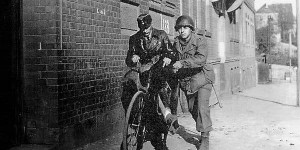 The units of the 104th Infantry Division “Timberwolf” of the US Army approach the city of Halle from the west. A task force was formed especially for the capture of the city of Halle, the TF Kelleher, named after its commander Col. Gerald C. Kelleher. This task force consisted of two battalions, the 1st and 3rd battalions, which were also named after their commanders. It was the TF Clark and TF Rouge (Lt. Col. Robert R. Clark and Lt. Col. Leon J.D. Rouge). These approach the city of Halle to take the Saale over the still existing bridges. Clark took over the southern part of the thrust, Rouge the northern part, which should lead his unit to Kröllwitz. They arrived there around noon. Gun battles ensued and contemporary photographs show battle tanks and soldiers on the Kröllwitzer Berg (see the picture). But shortly before the American scouts reached the bridge, the German defenders had blown it up.
The units of the 104th Infantry Division “Timberwolf” of the US Army approach the city of Halle from the west. A task force was formed especially for the capture of the city of Halle, the TF Kelleher, named after its commander Col. Gerald C. Kelleher. This task force consisted of two battalions, the 1st and 3rd battalions, which were also named after their commanders. It was the TF Clark and TF Rouge (Lt. Col. Robert R. Clark and Lt. Col. Leon J.D. Rouge). These approach the city of Halle to take the Saale over the still existing bridges. Clark took over the southern part of the thrust, Rouge the northern part, which should lead his unit to Kröllwitz. They arrived there around noon. Gun battles ensued and contemporary photographs show battle tanks and soldiers on the Kröllwitzer Berg (see the picture). But shortly before the American scouts reached the bridge, the German defenders had blown it up.
What now?
The Americans had already built a pontoon bridge near Friedeburg in the Saalkreis. The “Timber Wolves” were ordered there, and on the night of April 14-15, the units crossed the Saale.
New command: The capture of the city of Halle from the north. That happened on April 15th.
April 15, 1945
 After crossing the Saale near Friedeburg at night and in the early morning of the current day, US troops approached the city’s northern border using the existing road network. The first measures of the crew were taken in Trotha. This secured the electricity works and the area of the port, because it was feared that they would be destroyed by German troops (scorched-earth tactics based on Hitler’s “Nero Command”). The Americans found Trotha intact and were able to contact the German defenders through the functioning telephone network. Here they demanded surrender and were otherwise threatened with air strikes and artillery fire. The German defenders refused, but in the city courageous tried to avert the impending fate. For example, a group led by Prof. Lieser printed leaflets asking the German population to raise white flags as a sign of surrender. Many responded to this call, and since it was too dangerous to hoist it towards the street, white cloths were instead placed on roofs and in inner courtyards for the American reconnaissance aircraft to see; a plan that worked. The university employee Dr. Georg Braude made his way to the Americans and could even speak to Col. Kelleher. Braude could not achieve anything, but Kelleher gave him a letter to Graf Luckner asking him to throw his weight into the car seat. So the day passed without the threat of air strikes. Leaflets were hastily printed under the direction of Col. Plaisted, on which the Halle population was clearly warned: “Surrender or destruction”.
After crossing the Saale near Friedeburg at night and in the early morning of the current day, US troops approached the city’s northern border using the existing road network. The first measures of the crew were taken in Trotha. This secured the electricity works and the area of the port, because it was feared that they would be destroyed by German troops (scorched-earth tactics based on Hitler’s “Nero Command”). The Americans found Trotha intact and were able to contact the German defenders through the functioning telephone network. Here they demanded surrender and were otherwise threatened with air strikes and artillery fire. The German defenders refused, but in the city courageous tried to avert the impending fate. For example, a group led by Prof. Lieser printed leaflets asking the German population to raise white flags as a sign of surrender. Many responded to this call, and since it was too dangerous to hoist it towards the street, white cloths were instead placed on roofs and in inner courtyards for the American reconnaissance aircraft to see; a plan that worked. The university employee Dr. Georg Braude made his way to the Americans and could even speak to Col. Kelleher. Braude could not achieve anything, but Kelleher gave him a letter to Graf Luckner asking him to throw his weight into the car seat. So the day passed without the threat of air strikes. Leaflets were hastily printed under the direction of Col. Plaisted, on which the Halle population was clearly warned: “Surrender or destruction”.
 The US troops were preparing to attack. Artillery positions were set up west of the city.
The US troops were preparing to attack. Artillery positions were set up west of the city.
Two more pontoon bridges were built in Brachwitz (see the picture on the right). This was used to gather additional forces in Trotha.
Plans for the coming day and the impending capture of the city of Halle were made.
The following day, the fate of the city of Halle was decided.
April 16, 1945
Yesterday’s plans were to dare to enter the country in the hope that the German resistance would fail after yesterday’s warnings. The north of the city had been divided in half by the “Timber wolves”, the border of which was Trothaer Straße. TF Rouge operated west of it, TF Clark operated east. Clark, however, had additionally been ordered to surround the city and to secure the arterial roads leading to the east by creating roadblocks; this was a consequence of yesterday’s German refusal to stop the defense. As a result, the sector originally to be occupied by TF Clark was initially only dealt with secondarily.
TF Rouge, on the other hand, was slowly advancing, with some fierce resistance on the German side. The Timber wolves advanced along Trothaer Strasse, later along Seebener Strasse. Especially in Giebichenstein there were violent house fights with victims on both sides; Even today, bullet marks on houses e.g. on Seebener Strasse. Some of the Timber wolves first had to kick in the doors of the houses to seek and fight the German defenders. The most fierce fights took place around and on the cemetery located between Großer Brunnenstraße and Friedenstraße (no longer exists today).
According to the original – little resistance was expected, the city of Halle should have been left with a lot of medical personnel in the previously liberated Mittelbau Dora concentration camp – plans had long been in the hands of the US troops. So the army command in Washington asked how the city was doing. When they heard that the advance was slow, they ordered it to be taken by all military means. Nevertheless, the local Americans did not give up hope of a peaceful solution. As already mentioned, it was known that Count Luckner lived in Halle. The Timber Wolves had received this tip from the war correspondent Al Newman, who worked for NEWSWEEK, and who met the count in the United States in the 1920s. Newman offered to go with a colleague to find Luckner so that the helm might be turned at the last minute. Newman and his companion set off.
At the same time, efforts to achieve a peaceful end intensified in Halle, which was also achieved by the attackers increasing the pressure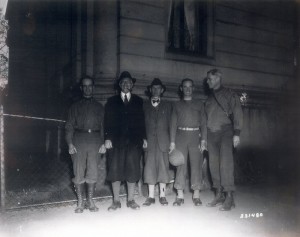 . The Red Tower was shot at and badly damaged. The chief of the German defenders, Gen.Lt. Radtke had signaled that Luckner’s trip to the Americans should not be put in the way. Luckner himself had agreed to drive over the front line in order to work for a peaceful solution with the timber wolves. In the late afternoon, the count set out with Major A.D. Karl Huhold on the way. Newman and his companion “accidentally” met Luckner and Huhold in today’s Carl-Robert-Strasse. Happy about the quick and successful completion of their mission, the two American war correspondents organized the transport of the German negotiators to the command post of the US troops in Trotha, where they met Col. Kelleher. Mj.Gen. Terry de la Mesa Allen, head of the Timber Wolves, was informed and immediately went to Trotha.
. The Red Tower was shot at and badly damaged. The chief of the German defenders, Gen.Lt. Radtke had signaled that Luckner’s trip to the Americans should not be put in the way. Luckner himself had agreed to drive over the front line in order to work for a peaceful solution with the timber wolves. In the late afternoon, the count set out with Major A.D. Karl Huhold on the way. Newman and his companion “accidentally” met Luckner and Huhold in today’s Carl-Robert-Strasse. Happy about the quick and successful completion of their mission, the two American war correspondents organized the transport of the German negotiators to the command post of the US troops in Trotha, where they met Col. Kelleher. Mj.Gen. Terry de la Mesa Allen, head of the Timber Wolves, was informed and immediately went to Trotha.
Negotiations took place there between 5 p.m. and 6 p.m. (which, incidentally, were conducted by the count, because Huhold was only able to speak English to a limited extent), which ultimately convinced the Americans that the bomber groups already ordered (750 heavy bombers and 260 fighter-bombers had attacked) not to be used in Halle. What Luckner achieved with all of his popularity and with reference to his way of waging war in World War I was to dissuade the Americans from their original request for the city to be handed over. After the negotiations one was satisfied with a partial withdrawal; Lindenstrasse (today: Willy-Brandt-Strasse) / Torstrasse was designated as the new front line. The German troops should therefore have withdrawn from the historic city center by April 17 morning. If the US Army considers this condition to be met, the bombing will be finally dispensed with. This condition was met by the Germans at night. Halle was saved and Count Luckner can be described as one of the city’s saviors.
April 17, 1945
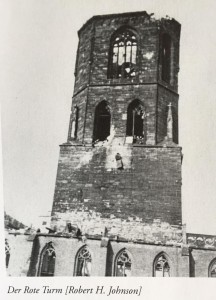 Many Timber wolves reported from their anxious memories, because they had spent the night of April 16-17 in unrest, given that they had been ordered to hide in shelters or cellars that were as safe as possible, because the lower ranks of the soldiers had information was passed, the city center would be destroyed by bombers at night.
Many Timber wolves reported from their anxious memories, because they had spent the night of April 16-17 in unrest, given that they had been ordered to hide in shelters or cellars that were as safe as possible, because the lower ranks of the soldiers had information was passed, the city center would be destroyed by bombers at night.
#Missing hits were expected in the northern parts of the city, from which US troops were trying to be saved. In some cases, units from areas already occupied had been slightly withdrawn.
But the expected catastrophe did not occur, because the German defenders did what had been mediated the previous evening by Count Luckner and Karl Huhold.
After awakening, the US associations gathered and slowly advanced into the city center. A veteran is quoted as saying: “I looked out the window of the basement where I had spent the night and saw that nothing had been destroyed. On the contrary, civilians were running around. I went outside where the picture was confirmed. I thought , peace had broken out and I simply slept through it. “
Slowly, the entire historic city center of Halle was gradually occupied without incidents. The Timber Wolves registered this and from now on refrained from using any heavy war equipment.
 Halle was finally saved from complete destruction.
Halle was finally saved from complete destruction.
By the way, while the Count was still driving along the front line to the Americans with Huhold and the Mayor of Weidemann in Halle that night, the relatives of Luckner were brought to the American headquarters by US soldiers the next day, because revenge acts by the German army wolves were expected; the perfidious system of clan rule prevailed, which often put family members of resistance fighters and other opponents of the Nazis at risk. Luckner’s family was to be protected from this.
While the post-war period began in the north of Halle and the city center, the city’s population south of the new front line Lindenstraße (Willy-Brandt-Straße) / Torstraße was worried about what the next few hours would bring.
April 18, 1945
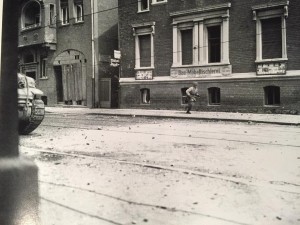 Fighting continued south of the new frontline negotiated on April 16 (already mentioned), although not with the same intensity as in the north only two days earlier. The war diaries still report a German counterattack, which, however, was successfully repelled.
Fighting continued south of the new frontline negotiated on April 16 (already mentioned), although not with the same intensity as in the north only two days earlier. The war diaries still report a German counterattack, which, however, was successfully repelled.
TF Clark was still busy holding the roadblocks that were being built or the roadblock planned in the southeastern part of the city. Because of the fighting, this was only possible with considerable delays, so that large parts of the German defenders and their commander Gen.Lt. Radtke managed to escape south of the city. TF Rouge advanced in the city itself (the picture shows an American soldier under fire in Böllberger Weg at the level of today’s Künstlerhaus 188).
There was an almost catastrophe at the Hartmann paint factory. German scouts had entrenched themselves on the tower there, so that an American attack by means of artillery and possibly air support was feared should the GI’s notice the Germans. Such an attack could have had devastating consequences if there were many paints and chemicals in the tower and in the surrounding buildings, the firing of which could have been – to put it mildly – extremely disadvantageous for the environment. Happy circumstances prevented worse.
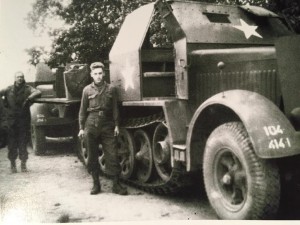 In Ammendorf, US troops discovered an undamaged production facility for half-track vehicles in a factory. The entire workforce was diligently on site (German discipline) and did not have to be “asked” for long to resume production until the supplies of material had been used up. So the soldiers of the infantry suddenly got vehicles (the white American star was quickly painted on them so that they would not be attacked by their own aircraft), with which they could quickly reach their next destination.
In Ammendorf, US troops discovered an undamaged production facility for half-track vehicles in a factory. The entire workforce was diligently on site (German discipline) and did not have to be “asked” for long to resume production until the supplies of material had been used up. So the soldiers of the infantry suddenly got vehicles (the white American star was quickly painted on them so that they would not be attacked by their own aircraft), with which they could quickly reach their next destination.
House after house, street after street, quarter after quarter were conquered in the south and ultimately brought into American hands.
In military hospitals and prisoner-of-war camps, the US soldiers were happily received by Allied combatants detained there; for them, the war was over, as was also more than indicated for the city of Halle, because dark times were almost over for our city.
April 19, 1945
The fighting ended in Halle on April 19 at 10.55 a.m. So it is in the official “after action reports” of the US Army.
World War II was over for the city.
This had brought suffering to us and especially to the people living here, because destruction and death were also to be complained about here.
Bombing victims are found in the city’s cemeteries.
Furthermore, many families based in Halle complained of fathers or sons who remained on the battlefields of Europe and could only be kept alive in mourning memories.
 In our city, too, people from other cities or countries died, be it in captivity, in military hospitals, in prisons or just during the march of US troops that had been the focus of attention in the past few days in mid-April 1945. In the case of the latter, American wives and mourned / or mothers for your boys and men who didn’t come home alive.
In our city, too, people from other cities or countries died, be it in captivity, in military hospitals, in prisons or just during the march of US troops that had been the focus of attention in the past few days in mid-April 1945. In the case of the latter, American wives and mourned / or mothers for your boys and men who didn’t come home alive.
So the war has also claimed victims in our city and has caused serious wounds. Each individual victim is one too many and may serve as a warning that such madness (is this the right word? Is there a right word at all?) should never be repeated.
We should all contribute in this direction.
Remembering here also means mourning. Nonetheless, April 19 should be a day every year on which we remember that in Halle, in the fateful days before this date, reason prevailed. People acted, communicated with each other and were guided by reason and above all emotion, humanity and heart. This happened elsewhere in World War II, but it is probably unique in relation to a German city. For this reason, the positive fate of Halle belongs in the history books as well as the better known examples of the opposite kind.
On April 19, 1945 there was peace in Halle. For this reason the church bells have ringed for 10 minutes from 10.55 a.m. in 2010 as the “Peace Bells of Halle”.May their sound flow out into the world and bring a little piece of peace to our globe.
Promoting peace is one of the goals of the international Felix Graf von Luckner Society.
+++ THE END +++